Hangzhou SightseeingVisit Hangzhou's Landmarks and Immerse in Chinese Culture Hangzhou has been ranked as one of the ten most scenic cities in China renowned for its historic relics and natural beauty. Although Hangzhou has been through many recent urban developments, it still retains its historical and cultural heritage. Today, tourism remains an important factor for Hangzhou's economy.
West Lake (Xihu) is Hangzhou's most famous and most popular scenic sight. The lake covers an area of six square kilometers and includes some of Hangzhou's most famous historic and scenic places. The area includes historical pagodas, cultural sites, as well as the natural beauty of the lake and hills. Technically, there are ten must see scenes in the West Lake:
till the West Lake itself can be divided into countless smaller sites, from Mr. Guo's villa to Orioles Singing in the Willows. Some of the must see areas with a short description of each in the West Lake area are as follows. Three Pools Mirroring the Moon Built in the early 1600s, this is the largest island on the lake. When there is a full moon, candles inside the pagodas are lit, and in the candlelight something magical appears. Mid-Lake Pavilion The Mid-Lake Pavilion is the oldest island in the West Lake area. On this island, there is a Chinese inscription on the Qing Dynasty era stone arch where the Qing Emperor in 1552 wrote "Chong Er" meaning "Endless Love". Lord Ruan's Mound This is a mound which was made by the piling up of dirt after the dredging of the lake 200 years ago. On a summer's night, entertaining activities take place in the garden on the island. Hubin Park Hubin Parks numbers one, three, six and other numbered parks in between are the parks between Hubin Road and the West Lake. These parks are good to sit for a bit, eat ice cream or read a newspaper. You can also rent a boat from the docks at each park and enjoy a scenic lake from the water. Su Causeway The Su Causeway in West Lake is almost 3 kilometers in length. This causeway dates back to year 1189 and is richly covered with a bunch of willows and peach trees. Bai Causeway Starting at the eastern end of Beishan Road, the Bai Causeway leads to the Solitary Hill and cuts off the distances between Hubin Road and the Shangri La. Yang Causeway This one is more than 3 kilometers in length and one road west of the Su Causeway. Running north south, the Yang Causeway starts at the intersection of Beishan and Shuguang Road which becomes Yang Causeway once you are south of this intersection. The Yang Causeway includes the Quyuan Garden, which is the most popular spot to see tons of lotus blossoms. The water area to the west of the top of Yang Causeway is Maojiabu Scenic area, with orchids blended into the water scenery. Another tourist spot on Yang Causeway is Mr. Guo's Villa, is was built in 1907 and is considered one of the most "classical" gardens in Hangzhou. At the southern end of the causeway, just before Nanshan Road, is a fish-viewing pond. Zhongshan Park
King Qian's Memorial Five Kings of the Wuyue Kingdom are buried here in the King Qian's memorial on the south end of the West Lake off Nanshan Road. Gushan
The place he lived in seclusion was called Gushan. Gushan, situated at the northwestern corner of West Lake, is 38 meters (about 125 feet) above sea level, and covers an area of nearly 50 acres. It is the lowest summit, compared to other hills around West Lake, but it is also the biggest island in the lake and the only natural island as well.
Gushan boasts of beautiful landscapes. It is bordered by Bai Causeway on the east, Xi Ling Bridge on the west, the Outer West Lake on the south, and the Inner West Lake on the north. Autumn Moon over the Calm Lake, one of the ten scenes of the West Lake; is formed on the boundary of Gushan and Bai Causeway. Gushan is an ideal place to enjoy the beauty of West Lake. In addition, there are a lot of cultural relics in the scenic area. Wushan Square Wushan Square and Wushan Hill is a major town center in Hangzhou. The view from the top is excellent on a clear day, and there are also trails around the hills from behind the pagoda. The pagoda itself has been modernized with an elevator and nice open-air teahouse at the top, but the original bell is still intact and in use. This area also features easy access to Hefang Jie shopping street at the base of the hill, full of small pedestrian streets and shopping stalls. It is also extremely close to the West Lake itself. Jade Emperor Hill The Jade Emperor Hills is one of the least visited sites in Hangzou despite its somewhat central location. This hill does not feature any prominent pagodas or temples, but it still provides a quiet escape and a nice walk. It is located directly south of Leifeng Pagoda.
The Six Harmonies Pagoda is located down by the Qiantang River, about a 15 minute cab ride from the lake in light traffic. The road to drive there is quite pretty as it goes through all the tunnels and tea fields. Besides the pagoda there is a park with hundreds of realistic replicas of the world's most famous pagodas, complete with mini-sized trees in front of the pagoda models. Lingyin Temple Lingyin Temple, meaning "heart of the soul's retreat", is located west of the West Lake is an active Buddhist temple at the bottom of a hill. Nearby you can take a chairlift to the top of the hill where there is another temple, but it you prefer you can walk up the set of stairs below the chairlift. The Lingyin Temple is one of the three oldest and most famous temples in China.
The Leifeng Pagoda was originally built in 975 and it used to stand on the slopes of Nanping Mountain on the southern bank of West Lake in Hangzhou. But all that remains now of the original pagoda is the crumbling foundation, viewable from outside the glass case that it is housed in. With escalators, elevators, and a totally new pagoda places on top of the foundation, there is not much to see within the pagoda itself. The Leifeng Pagoda was an octagonal, five-storied structure built of brick and wood. The body of the pagoda was made of brick, but the eaves, balconies, inside landings and balustrades were made of wood. Stones with the Huayan Scriptures inscribed on them were inlaid on the inner walls of the pagoda. Compared to other Pagodas, Leifeng Pagoda had the saddest history. During the Yuan Dynasty it was a magnificent building "of ten thousand chi" standing "aloft as if in midair." It suffered a most severe disaster during the Ming Dynasty. During the Jiaqing years (1522-66) Japanese invaders set fire to the pagoda and burned the coves, balconies, balustrades and steeple to ashes, leaving only a brick skeleton. Later some superstitious and ignorant people often took bricks from the pagoda in the belief that the abrasive powder of the bricks was a magic remedy that could cure all diseases and keep a fetus from aborting. Others stole Buddhist scriptures from the pagoda in order to make money. Finally, in August 1924 the foot of the pagoda was dug hollow and other parts of the pagoda were so severely damaged that the ancient pagoda suddenly collapsed. In the debris of the fallen pagoda some Buddhist scriptures were found in a brick hole. At the beginning of the scriptures it was written that the pagoda was constructed by the King of Wuyue, Qian Hongchu, and that total of 84,000 volumes of Buddhist scriptures had been stored in the pagoda. It was dated 975, the last year of the state of Wuyue. The pagoda was most recently rebuilt in 2000 and visitors can get one of the best views of the city skyline from there. Also, some of the smaller seating areas around the perimeter of the pagoda have a nice breeze and view of the pagoda structure. Jingci Temple Off Nanshan Road, built in 954, this has a huge 10 ton bell inside it. Located on Nanping Road, the bell rings 108 times to celebrate the Chinese New Year. The bell is also rung every evening, but for much fewer times.
Wuzhen
Also, setting it apart from other towns, Wuzhen gives a unique experience through its profound cultural background. It is said that people have lived in Wuzhen for 7000 years and over time the town has produced a galaxy of talents. Mao Dun, an outstanding modern Chinese writer, was born here and his masterpiece, 'The Lin's Shop', describes vividly the life of Wuzhen. In 1991, Wuzhen was authorized as the Provincial Ancient Town of History and Culture, so ranking first among the six ancient towns south of the Yangtze River. Wuzhen's uniqueness lies in its layout, being 2 kilometers (1.24 miles) long and divided into six districts. These are Traditional Workshops District, Traditional Local-Styled Dwelling Houses District, Traditional Culture District, Traditional Food and Beverage District, Traditional Shops and Stores District, and Water Township Customs and Life District. Wandering along the east-west circuit created by these six districts, you will enjoy the atmosphere of the traditional cultures and the original ancient features of the town that have been preserved intact. The Former Residence of Mao Dun The former residence of Mao Dun, a well-known Chinese revolutionary writer, was originally built in the central 19th century. It covers a total area of 650 square meters (7020 square feet) and it was the Mao family home for many generations. In 1984, the former residence of Mao Dun was renovated and extended to cover a total area of 1,731.5 square meters (18,700 square feet). In 1988, it was listed as one of the Key State Preserved Relic Units and in 1994 was renamed the Mao Dun Museum of the City of Tongxiang. The house has three exhibition areas: Wuzhen, the Hometown of Mao Dun, the Way of Mao Dun, and the Former Residence of Mao Dun. The present Mao Dun Museum can be found to the east of the residence, which used to be Lizhi Shuyuan (Aspiration Academy) where Mao Dun spent his early school years. Fanglu Pavilion
It is said that Lu Yu once mistakenly ate some poisonous leaves and was rescued by Lu Tong, who happened to collect tealeaves at that time. In return, Lu Yun taught Lu Tong knowledge of tea and tea making skills, which resulted in the prosperity of LuTong's teahouse. Suggested by one guest, Lu Tong changed the house's name to Pavilion of Visits to Lu, to memorize this respectable scholar. Located to the south of Ying Bridge and backing onto the city river, the teahouse enjoys a broad view of Guanqian Street and provides visitors with pleasant relaxation. Hupao Spring
Hupao Spring forms as the result of underground water seeping through veins and cracks within quartz sandstone that is not eroded by acid materials. Due to its low content of mineralized ingredients and its high percentage of radon (a radioactive element), the spring water, which tastes pure, sweet and cold, is an ideal beverage for good health. Most interestingly, the spring water rises three millimeters above a bowl edge without overflowing even if a coin is put into the bowl, a scientific phenomenon made possible by the high surface tension of the spring water. Today, Hupao Spring and the surrounding twisting valley have been turned into the Tiger Running Spring Forest Park. On the site is Li Shutong Memorial which was erected in honor of the scholar and hierarch who was outstanding in the fields of music, drama, painting, and calligraphy. Mount Putuoshan Scenic Spot Mount Putuoshan lies to the east of Zhoushan City. Zhoushan City is situated on Zhoushan Island that in turn gives its name to a group of some four hundred small islands off the east coast of China in Zhejiang Province. These islands are in fact the peaks of submerged mountains and so rise steeply from the sea. Mount Putuoshan dominates the small rhomboidal landmass with its total area of about 12.5 square kilometers (4.8 square miles). The mountain is of one of four in the country that are held sacred by Buddhists and it was here that over the centuries a once large Buddhist community was to evolve. The island's scenic beauty meant it was the perfect setting for temples and other religious buildings. In due course, it became known as the "Heaven of the Sea and Kingdom of the Buddhists". In its heyday, the island had eighty-two temples and nunneries together with some one hundred and twenty-eight shelters that between them housed 4,000 Buddhist monks and nuns. Even today visitors to the island will encounter monks in their traditional robes as they walk along the many paths that cris-cross the picturesque landscape. The major sites to visit on the island are:
This island is famed for having such a delightful combination of mountain scenery and seascapes. Twin Peaks Piercing the Clouds The Twin Peaks Piercing the Clouds refers to South Peak and North Peak at the West Lake scenic spot. In reality however, neither peak is very high. South Peak is 256.9 meters (843 feet) in height, and North Peak is 355 meters (1,165 feet). They face each other across a distance of about 5 kilometers (3.1 miles). The natural scenery here is exceptionally beautiful, especially when it is cloudy or after a rainfall. At that time, only the two tips of the peaks can be seen in the thick fog. It looks as if the fog is being pierced only by the two peaks, thus the name 'Two Peaks Piercing the Clouds'. Long ago Buddhist monasteries and pagodas were constructed on the tops of the two peaks. This place became a great attraction and was listed as one of the ten famous scenic sites of West Lake during the Southern Song Dynasty (1127-1279).
Lin Feng-Mien's Residence Address:No. 3 Lingying Road (Main Entrance of Botanical Garden), Hangzhou Guo's Villa This 140 year old garden-like villa is a nice way to travel back to the Qing Dynasty. It's the best existing traditional private garden in Hangzhou. It is one of the garden masterpieces of Jiangnan, the lower region of the Yangtze River, with incomparable surroundings and the smartly managed garden space. Address:No. 28 Yanggongdi, Hangzhou Su Dongpo Memorial Hall Address:No. 1 Nanshan Road, Hangzhou Pan Tianshou Memorial Hall Address:No. 95 Nanshan Road, Hangzhou Sui Villa Huang Binhong's Memorial Hall Address:No. 31 Qixialing Road, Hangzhou Hu Xueyan Tang Villa Address: Yuanbao Street, Wangjiang Road, Hangzhou Mausoleum of General Yuefei
As a result, Yuefei was falsely accused and later secretly killed in jail. A few years later, the wrong was put right when Emperor Xiao Zong (1163 - 1189) came to power. The Mausoleum of General Yuefei was built in memory of this great hero. Yuefei has always been considered a national hero. His tomb, which had been destroyed several times, was rebuilt and possesses the features of the Song Dynasty. Facing the tomb are four iron sculptures, including Qinhui the chief plotter, in kneeling position. Southern Song Dynasty Guan Kiln Museum
There are three rooms in the exhibition area. In the first exhibition room, many delicate chinaware treasures of past dynasties unearthed in Hangzhou are on display. While in the second room, one can study the history of China's ceramics as well as the social, political and economic base and development after the establishment of guan kilns in Southern Song Dynasty. And in the third one, visitors can see the fruits of research on the ancient porcelain of China and the products in imitation of the famous products of kilns made by modern technology. Now, over 8,000 restored chinaware samples dug up from the site are on display in the exhibition area. In the Southern Song Dynasty Guan Kiln Museum, there is a pottery bar with a unique style. Visitors can see for themselves how pottery was made long ago. They can also have the experience of making their own pottery, and so enter into the hardship and exhilaration that must have been the lot of people in ancient times.
The museum owns eight exhibition halls, including: the Preface Hall, Relics Hall, Folk-custom Hall, Dyeing and Weaving Hall and Modern Achievements Hall. The Preface Hall introduces the 5000 year long history of Chinese silk culture. China is the earliest country that engaged in sericulture, filature and making clothes with silk. This hall provides strong evidence for this fact and shows the history of the Silk Road through which silk was spread abroad. Folk Custom Hall displays some prominent products created by outstanding weavers. Dyeing and Weaving Hall tells people how to dye and weave silk and the scientific theory of it. There are also weavers showing the whole process. Tourists are welcome to participate in the activity and do it themselves. Modern Achievements Hall displays the achievements of New China in silk production, silk research and silk trade and so on.
Fei Lai Feng, 209 meters (about 700 feet) tall, is a pure limestone mountain that is very distinctive from the sandstone mountains around it. Large stones scattered along the peak are said to resemble animals like a flying dragon, a running elephant, a crouching tiger, and a fleeing monkey. On the other side of the peak, a pavilion named Cui Wei was erected to immortalize the national hero Yue Fei. This man contributed greatly in the war against Jin Tribe during the Southern Song Dynasty (1127-1279). The pavilion was destroyed many times before the large restoration of 1942. The current pavilion keeps its old face with fresh paint. The caves of this mountain shelter about 330 stone statues dating from the 10th to the 14th centuries. The statues appear in a variety of poses ranging from standing, to sitting, to sleeping. A favorite may be the Laughing Buddha, sitting on the cliff along the stream with exposed breast and belly. If you wonder why he has such a big belly, the answer is that his belly is where the Buddha keeps all of the world's troubles. The question always comes out "why are there so many Buddha statues in the cave?"Local legend has it that the peak had destroyed many villages before it settled down in Hangzhou. In order to prevent the peak from causing even more damage, over 500 Buddha statues were caved out of the peak to suppress it. Consequently, the water-eroded caves in the peak are regarded as the very birthplace of many local legends. In 1993, a new site by the name of "China Grotto Art Garden" was set up around the Fei Lai Feng beauty spot. Thousands of professionals in the fields of engraving and grotto research flock to this place to study the unparalleled Chinese classical rock carvings. Among all the mountains around West Lake, Fei Lai Feng is the one most likely to simulate the imagination and make one reluctant to leave.
The Grand Canal is noted as one of the most magnificent and wondrous constructions in ancient China. The canal can really offer one a profound look into China's fascinating, historical past. Running 1,764 km (about 1200 miles) in length, the Grand Canal is the longest man-made waterway, as well as the grandest in ancient China, far surpassing the next two grand canals of the world: the Suez and Panama Canals. Running from Hangzhou, Zhejiang Province in the south to Beijing in the north of China and connecting different river systems, the Grand Canal contributed greatly to ensure that the Chinese primary economy thrived in past dynasties. Now more than 2000 years old, some parts of the canal are still in use, mainly functioning as a water diversion conduit. The canal today was built section by section in different areas and dynasties before it was linked together by the Sui Dynasty (581-618). In 604 AD, Emperor Yangdi of the Sui Dynasty toured Luoyang (now the city in Henan Province). The following year, he moved the capital to Luoyang and ordered a large-scale expansion of the Grand Canal. The primitive building techniques stretched the project over six years. Approximately half the peasant builders (about 3,000,000) died of hard labor and hunger before it was finished. This project was thought to have been wasteful of manpower and money, which resulted in the downfall of the Sui Dynasty. As a major transportation hinge in past dynasties, the Grand Canal interconnected the Yangtze, Yellow, Huaihe, Haihe, and Qiantang Rivers and flowed through Beijing, Tianjin, Hebei, Shandong, Jiangsu and Zhejiang with Hangzhou at its southernmost end. The Grand Canal, which joined the river systems from different directions, offered much facility to transport foods and goods from south to north in past times. Just as importantly, it greatly improved the administration and defense of China as a whole and strengthened economic and cultural intercourse between north and south. Boating on the old Chinese Canal is one of the best ways to get a panoramic view of the landscape of typical river towns in southern China, which includeancient dwellings, stone bridges of traditional designs and historical relics. Experiencing some of the local customs offers much delight to travelers. Tourists also have an opportunity to enjoy good food while appreciating the surrounding scenery. Boating along the hangzhou-Beijing Grand Canal is becoming more popular.
The garden is divided into two main sections: the research section and the pleasure gardens. The research section is where the cultivation of plants and protection of the environment are being studied. The pleasure gardens are divided into gardens including the Botany Classification Garden, Botany Appreciation Garden, Bamboo Garden, Garden of Economic Plants, PlantResources Museum, and the Medicinal Garden. In the Botany Appreciation Garden, the 'Lingfeng Tanmei' in the Botanical Garden is an excellent scene that really catches tourists' eyes: Over 5,000 plum trees are standing upright. When winter comes, the majestic and charming picture of plum trees stretching up, towards the cold wind and snowflakes falling onto plum blossoms are an amazing sight. Each garden has unique features. The Bamboo Garden is special and interesting: A kind of bamboo named Damaozhu grows very fast, reaching 1 meter (approximately 3 feet) in height during one night and growing as tall as a three-stories building during one month. Some bamboos are small like grass, and some have spots on stems. In the Garden of Economic Plants, plants are visible which can be used to produce fiber, medicine, flavors, or special kinds of industrial materials. They provide tourists not only with the wonderful scenery of flourishing trees but also an ideal place for summering. Some entertainment facilities in the botanic garden offer tourists a chance to relax to their hearts content. No matter what season it is, the garden will give tourists endless pleasure. The beautiful Yulan trees in spring, the leisure hours spent viewing the lotus or on the hammock forest in summer, the fragrance of sweet-scented-osmanthus in autumn, the pines and bamboos, which are still green and vigorous in winter, add great pleasure to any visit here. Address: Taoyuanling, Xihu District, Hangzhou
The zoo is home to pandas and many other animals. It is conveniently located just south of the lake. The entrance fee includes a circus-style animal show with tigers, lions, bears and elephants that is particularly entertaining for children. Address: No. 40 Hupao Road, Hangzhou
The Thousand Islets Lake (Qian Dao Lake) is noted for its verdurous mountains, crystal clear water, exotic caves and strange stones. It lies in Chun'an County, about 150 km (93 miles) west of Hangzhou City and is 140 km (87 miles) southeast of Mount Huangshan. It is a resplendent pearl in the classical golden route of Hangzhou. Thousand Islets Lake and Mount Huangshan has become popular all over the world.
Nongfu (farmer) Spring Water, a famous mineral water brand in China, comes from Qiandao Lake. The scenic area can be divided into six sections on the basis of geographical location. They are: Southeast Lake District (the first to be developed), Central Lake District (combining several spots that should not be missed), Southwest Lake District, Northeast Lake District, Northwest Lake District and Fuxi Stone Forest (the first stone forest in East China), each possessing their own unique and striking landscapes. Thousand Islets Lake is currently the largest forest park in China. It has been awarded many titles and received favorable comments from tourists both at home and abroad. The best time to visit the Lake is in autumn and winter, when there is less rainfall. Fine weather, cool and fresh air and clear water are really enjoyable. Do sample the distinctively cooked seafood and some local food here. Take home souvenirs like inkstones, hemp embroideries and products made of pearls. |

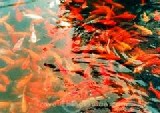 Zhongshang Park is the only natural island on the lake, where
Lou Wai Lou restaurant is located. At least three emperors have
constructed palaces here. Besides an expensive restaurant, the
popular area is the home of the Xiling Seal Engravers' Society,
and the seals, calligraphy, engraving-masters, and relics that
go along with it.
Zhongshang Park is the only natural island on the lake, where
Lou Wai Lou restaurant is located. At least three emperors have
constructed palaces here. Besides an expensive restaurant, the
popular area is the home of the Xiling Seal Engravers' Society,
and the seals, calligraphy, engraving-masters, and relics that
go along with it.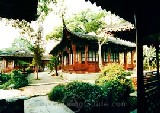 Gushan Island is the largest island in West Lake. It is situated
in its northwest corner and can be reached via Baidi, a dyke built
in the Tang dynasty. The story of the plum wife and crane son
is quite famous and it goes like this: Lin Bu, also called Lin
Hejing, was a real hermit and a talented poet in the Northern Song
Dynasty (960-1127). Besides composing poems and paintings, he
spent all his spare time planting plum trees and raising cranes.
He didn't marry in his entire life, and as a result, people took
plum blossom as his wife and considered cranes his children.
Gushan Island is the largest island in West Lake. It is situated
in its northwest corner and can be reached via Baidi, a dyke built
in the Tang dynasty. The story of the plum wife and crane son
is quite famous and it goes like this: Lin Bu, also called Lin
Hejing, was a real hermit and a talented poet in the Northern Song
Dynasty (960-1127). Besides composing poems and paintings, he
spent all his spare time planting plum trees and raising cranes.
He didn't marry in his entire life, and as a result, people took
plum blossom as his wife and considered cranes his children. 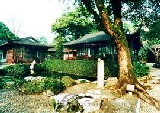 Gushan got this name because it is surrounded by water, standing
solitarily in West Lake. It can also be called Solitary Island,
for it is a lonely island; rather than a hill. Its other name:
Plum Blossom Island, originates from the flourishing plum blossom
planted on the hill.
Gushan got this name because it is surrounded by water, standing
solitarily in West Lake. It can also be called Solitary Island,
for it is a lonely island; rather than a hill. Its other name:
Plum Blossom Island, originates from the flourishing plum blossom
planted on the hill. 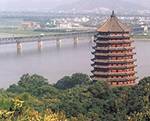 Six Harmonies Pagoda
Six Harmonies Pagoda  Leifeng Pagoda
Leifeng Pagoda For any visit south of the Yangtze River, one place not to be
missed is the town of Wuzhen. Located in the centre of the six
ancient towns south of Yangtze River, 17 kilometers (10.56 miles)
north of the city of Tongxiang, Wuzhen displays its two thousand
year history in its ancient stone bridges floating on mild water,
its stone pathways between the mottled walls and its delicate woodcarvings.
For any visit south of the Yangtze River, one place not to be
missed is the town of Wuzhen. Located in the centre of the six
ancient towns south of Yangtze River, 17 kilometers (10.56 miles)
north of the city of Tongxiang, Wuzhen displays its two thousand
year history in its ancient stone bridges floating on mild water,
its stone pathways between the mottled walls and its delicate woodcarvings.  Enjoying a well-deserved reputation as the best teahouse in Wuzhen,
the Fanglu Pavilion obtained its name from an accidental meeting
between Lu Tong, the owner, and Lu Yu, the Patron Saint of Tea
in Tang Dynasty (618-907).
Enjoying a well-deserved reputation as the best teahouse in Wuzhen,
the Fanglu Pavilion obtained its name from an accidental meeting
between Lu Tong, the owner, and Lu Yu, the Patron Saint of Tea
in Tang Dynasty (618-907). 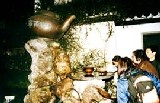 Hupao Spring is ranked the third in China for its spring water.
Hupao Spring is well famed for its unique fountain. Hupao Spring
is at the foot of the Great Compassion Hill, which is five kilometers
away from Hangzhou city. The Hupao Spring stretches between West
Lake and the Qiantang River.
Hupao Spring is ranked the third in China for its spring water.
Hupao Spring is well famed for its unique fountain. Hupao Spring
is at the foot of the Great Compassion Hill, which is five kilometers
away from Hangzhou city. The Hupao Spring stretches between West
Lake and the Qiantang River.  The Mausoleum of General Yuefei was built in memory of a famous
national hero, Yuefei (1103 - 1142). He was a great General famous
for wars against the Jin Dynasty (1115 - 1234) in the Song Dynasty
(960 - 1279). After he joined the army, he and his troops continuously
won wars against the Jin. However, after Yue and his army had
recovered most of the lost territory, Emperor Gaozong (1107 - 1187)
embraced the evil plot of Qinhui (1090 - 1155, Prime Minister of
the Song Dynasty) and surrendered to the Jin.
The Mausoleum of General Yuefei was built in memory of a famous
national hero, Yuefei (1103 - 1142). He was a great General famous
for wars against the Jin Dynasty (1115 - 1234) in the Song Dynasty
(960 - 1279). After he joined the army, he and his troops continuously
won wars against the Jin. However, after Yue and his army had
recovered most of the lost territory, Emperor Gaozong (1107 - 1187)
embraced the evil plot of Qinhui (1090 - 1155, Prime Minister of
the Song Dynasty) and surrendered to the Jin. 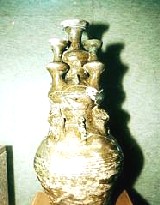 China is a country with a rich tradition of pottery and porcelain.
The history of pottery can be traced back through 8,000 years,
while porcelain in China has a history over 2,000 years.
China is a country with a rich tradition of pottery and porcelain.
The history of pottery can be traced back through 8,000 years,
while porcelain in China has a history over 2,000 years.  It was opened to public in 1992 and was extended in 2002. Now
the museum displays the products of the guan kilns of Southern
Song Dynasty, highlighting their charm and delicate beauty. It
has been praised as the Civilized Museum of Zhejiang Province and
the first group of Provincial Education Base of Patriotism. The
museum consists of two parts: the exhibition area and the guan
kiln relic.
It was opened to public in 1992 and was extended in 2002. Now
the museum displays the products of the guan kilns of Southern
Song Dynasty, highlighting their charm and delicate beauty. It
has been praised as the Civilized Museum of Zhejiang Province and
the first group of Provincial Education Base of Patriotism. The
museum consists of two parts: the exhibition area and the guan
kiln relic. China National Silk Museum is the first state-level professional
silk museum in China as well as the biggest silk museum throughout
the world. Situated at the southern bank of the West
Lake, in Hangzhou City of Zhejiang Province, it opened to the
public in 1992.
China National Silk Museum is the first state-level professional
silk museum in China as well as the biggest silk museum throughout
the world. Situated at the southern bank of the West
Lake, in Hangzhou City of Zhejiang Province, it opened to the
public in 1992. 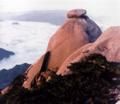 Fei Lai Feng stands next to Ling
Yin Temple and is a must see attraction in Hangzhou, Zhejiang
Province. There are many legends about the peak's name. A well-known
legend states that an Indian monk named Huili arrived in the
valley 1,600 years ago and was surprised to see a peak so dissimilar
from any other one in the valley. He believed that the peak
had flown over from India because the shape, although unique
in China, was common in India. However, he did not know why
the peak would have flown to this spot so far from his country.
Hence the peak's name was created and has passed down to the
present day.
Fei Lai Feng stands next to Ling
Yin Temple and is a must see attraction in Hangzhou, Zhejiang
Province. There are many legends about the peak's name. A well-known
legend states that an Indian monk named Huili arrived in the
valley 1,600 years ago and was surprised to see a peak so dissimilar
from any other one in the valley. He believed that the peak
had flown over from India because the shape, although unique
in China, was common in India. However, he did not know why
the peak would have flown to this spot so far from his country.
Hence the peak's name was created and has passed down to the
present day.  The
Hangzhou Botanical Garden covers an area of about 230 hectares
(approximately 568 acres) and it is located at the foot of the
Jade Spring Hill in the northwest end of the West Lake. It was
originally built in 1965, and is is not only a park in which to
feast your eyes on beautiful plants, but it is also a research
base where fields such as the cultivation of plants and protection
of environment are studied.The garden has wonderful scenery and
an excellent environment. It is beautiful with decorative architecture
including pavilions and kiosks. Verdant trees, colorful and lovely
flowers, and extremely fresh air seem to bring people into a world
full of the pleasure of natural beauty.
The
Hangzhou Botanical Garden covers an area of about 230 hectares
(approximately 568 acres) and it is located at the foot of the
Jade Spring Hill in the northwest end of the West Lake. It was
originally built in 1965, and is is not only a park in which to
feast your eyes on beautiful plants, but it is also a research
base where fields such as the cultivation of plants and protection
of environment are studied.The garden has wonderful scenery and
an excellent environment. It is beautiful with decorative architecture
including pavilions and kiosks. Verdant trees, colorful and lovely
flowers, and extremely fresh air seem to bring people into a world
full of the pleasure of natural beauty.
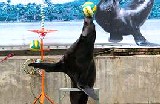
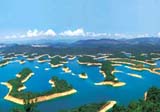 The Thousand Islets Lake offers something special, different from
the bustling metropolis.With 81% of the area covered in forests,
Thousand Islets Lake is a pure lake with clean, fresh air. It
is a young lake formed in 1959 as a result of the construction
of New Anjiang Hydroelectric Power Station. It is a beautiful
lake with 1078 islets showing different views in different seasons.
It is also a rich lake abounding with fish and surrounded by trees,
tea, mulberry (the food of the silkworm) and other fruit trees.
Qian Dao Lake is also a delightful lake with many activities including
enjoying the natural scenery and local culture, observing wild
animals and taking part in many exciting activities.
The Thousand Islets Lake offers something special, different from
the bustling metropolis.With 81% of the area covered in forests,
Thousand Islets Lake is a pure lake with clean, fresh air. It
is a young lake formed in 1959 as a result of the construction
of New Anjiang Hydroelectric Power Station. It is a beautiful
lake with 1078 islets showing different views in different seasons.
It is also a rich lake abounding with fish and surrounded by trees,
tea, mulberry (the food of the silkworm) and other fruit trees.
Qian Dao Lake is also a delightful lake with many activities including
enjoying the natural scenery and local culture, observing wild
animals and taking part in many exciting activities. 